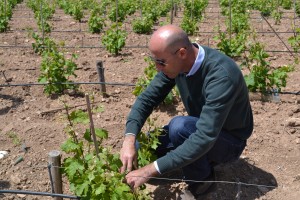 Earlier in the week, it was a beach scene like any other as the smell of fresh fish and salt water permeated. The sky had clouded over, the not-quite-summer air had turned cool and towel-wrapped children waited with their parents for the ferry back to the mainland. Only, this wasn’t Sag Harbor or Block Island; instead, we were on Favignana in the Egadi Islands, 45 minutes from Trapani, Sicily – an island off the coast of an island.
Earlier in the week, it was a beach scene like any other as the smell of fresh fish and salt water permeated. The sky had clouded over, the not-quite-summer air had turned cool and towel-wrapped children waited with their parents for the ferry back to the mainland. Only, this wasn’t Sag Harbor or Block Island; instead, we were on Favignana in the Egadi Islands, 45 minutes from Trapani, Sicily – an island off the coast of an island.
The island’s history dates to prehistoric times, but the only visible historic remnants date to medieval times when Swabians constructed the Castle of Santa Caterina at the top of the island’s only hill, from a pre-existing tower originally built by the Saracens.
Alternately called La Farfalla (the butterfly) due its shape, Favignana is named for the Favonio, a local westerly wind, which made its presence known, as I was shown around Firriato’s latest project. The Trapani-based winery was first established in the 1980s by Salvatore Di Gaetano, who is now joined by his wife, Vinzia, in running the family business, but while Firriato’s 320 hectares of vineyards are spread out over six Sicilian estates, it was the five hectares planted six years ago on Favignana that they were most excited about sharing with me. This selection of vines is the first and only vineyard to be planted on the island in 50 years.
Although Favignana is known for its twin industries of tuna and tufa, today’s islanders rely on tourism to make their livelihood. Yet, while the island is hospitable to tourists, it is less so to vines. The tufa-sand soils provide their own challenges, while the namesake wind necessitates that vines are bush trained using the alberello (little tree) method. At only several inches off the ground, the obvious need for hand-harvesting prompted me to commiserate with the vineyard crew, sensing the back-breaking work required (I certainly wasn’t inspired to volunteer).
Similarly, bamboo fencing tempers the wind and reduces the effect of salt water, which would otherwise burn the vines’ tender leaves. Their agronomist, Giovanni Manzo, advised that Zibibbo – a local clone of Moscato d’Alessandria (Muscat d’Alexandria) – is among the more resistant plants, which explains why these were planted closest to the sea.
But, despite these obstacles, the island’s climate also has a favorable impact. A high diurnal shift helps grapes develop good acidity and perfume. Meanwhile, the wind minimizes humidity, and subsequently, mildew, so much so that the operation is almost entirely organic.
Focused on indigenous varieties, the vineyard is planted to Cataratto, Grillo, Zibibbo, Perricone, and Nero d’Avola, with grapes shipped back to Trapani for production since its size doesn’t warrant the construction of a winery on Favignana. But, while these wines are currently labeled as IGP Sicilia, Firriato hopes to create a new Favignana-based DOC for them and will submit an application after the third vintage (2013) in keeping with legal restrictions.
After my vineyard orientation, Federico and Giovanni took me to lunch. But, before I had my fill of locally-caught, tonno rosso (blue fin tuna), swordfish and other wonderful seafood, all of which was simply prepared and delicious, we tasted through the Firriato wines, including two produced from the vines I had just seen.
In typical Sicilian style, we capped off the meal with a cannoli dessert and then indulged in some coffee to keep us awake. Post-lunch, the taxi driver did double duty as both driver and tour guide, having lived on the island his entire life. He showed us around, noting various points of interest and historical buildings. We stopped at an abandoned quarry that now functions as makeshift seaside cabanas and plays host to beach bathers. I was struck at the brilliance and clarity of the blue water below. Then, we climbed back in the car and headed to the port, the bright sun fading just as we arrived and joined the families as we all waited in earnest for the next boat.
